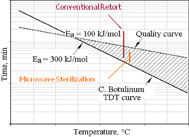
Control of Food-borne Bacterial and Viral Pathogens using Microwave Technologies
Intervention strategies are needed to control food-borne illness which continues to be a critical public health menace. The goal of this integrated project (for Program Area 4131) is to bridge scientific and engineering gaps which currently limit commercial applications of microwave technologies (MW) for the control of bacterial and viral pathogens in packaged foods, particularly ready-to-eat (RTE) foods, deli meats and seafood. Project objectives include: 1) understanding process requirements for inactivation of high risk pathogens, including Shiga toxin producing Escherichia coli, Salmonella, Listeria monocytogenes and human noroviruses in microwave-based pasteurization processes; 2) improving MW systems designs and 3) developing and validating protocols to control these pathogens in a variety of RTE foods. Technology development will emphasize in-package pasteurization and expanded sterilization protocols. To facilitate technology transfer, we will develop scale-up strategies to support industrial MW implementation. Statistical tools will be developed to predict product safety. From a consumer perspective, the primary objective is to develop MW technologies that yield safe foods with the greatest retention of “fresh-like” characteristics and excellent consumer appeal. Outreach activities include short courses, seminars and demonstration projects. Cross-disciplinary graduate education will be promoted through annual meetings and intercollegiate projects to build human capacity for leadership in advanced food preservation technologies. Research, education and outreach activities are outcomes-based and include appropriate assessments. The project will catalyze transfer and implementation of new MW heating technologies as an effective intervention method for a wide array of applications, with potential for significant, long term, positive impact on food safety.
